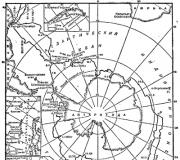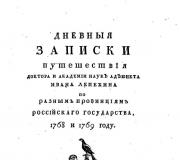Project "painting with wool". Methodological development “Drawing with wool Creative project painting with wool
Laying out paintings with wool is a process of layer-by-layer formation of an image from a fibrous material, in which the design is gradually formed from multi-colored strands of wool, layer by layer.
Drawing with wool follows the same principles as painting with paints. The volume of depicted objects is expressed in color, taking into account light and shade. Wool acts as a carrier of color; it is a dyed material that can be given the desired shape and laid out on a plane in the form of a pattern.
Video about the basics of painting with wool without falling over:
The formation of the picture occurs from the background to the foreground, i.e. first the background, then the foreground objects. In this case, the fibers are not fastened to each other in any way (in fact, under the weight of the glass, the wool settles, becomes compacted, and the layers hold each other quite tightly, but still this is not felting). The finished painting is a multi-layered loose cake made of wool fibers, enclosed in a rigid frame on both sides - glass and backdrop (see photo below). In other words, dry, unspun wool is laid out on a fabric base under glass. The backdrop is usually fiberboard (hardboard). To draw pictures with wool, it is very convenient to use clip-frames for photographs (glass + hardboard + clip-clamps).
You can use a regular photo frame purchased at any store, and for convenience between sessions, fasten the picture with paper clips. In this case, the painting will quickly rest, become flat, and work will be comfortable in the next session.

Tools and materials needed for wool painting:
- wool of different colors (selected for a specific subject), as well as fibers of silk, viscose, acrylic, etc.;
- scissors (the sharpest);
- tweezers (regular - for eyebrows);
- clip frame or regular photo frame, preferably the backdrop is rigid;
- non-woven fabric, felt, velvet paper or any fabric with a small pile as a backing (the backing is designed to hold the wool fibers on itself, this is the basis of the picture). Read more in the article: “Which substrate to use for painting with wool.”
If you are using non-woven fabric (it is transparent) and you plan to make the background of the painting very light, it is better to glue white paper onto the dark hardboard. The finished painting is framed.
Wool is mainly used for laying out paintings, but other fibrous materials can also be used: viscose, acrylic, silk, etc. It should be remembered that wool is easier to work with compared to other fibers. This is due to its physical properties. However, with the help of, for example, silk fibers, you can increase the decorativeness of the picture - elements with the addition of silk will reflect and refract light, which will create a lively play of light and shadow.
Wool in stores is most often sold in the form of ribbon, but you can also find carded wool.
Comb tape or tops- combed wool (see photo on the left below), in which all the fibers are pulled in one direction and laid in a ribbon.
Carded wool (carding, « wool wool") is a carding product (photo below on the right), in which, unlike combed sliver, all the fibers are curved and directed in different directions. It can be presented in a fleece or in the form of a carding strip.


For the first acquaintance with the technique of laying out pictures from wool, carding is not necessary. Wool wool can be easily obtained by pinching a combed strip.
Brief information about the technique... Wool felting (felting: from the English felt felt, felting, felting, stuffing) is a special handicraft technique, in the process of which wool for felting is used to create a pattern on fabric or felt, voluminous toys, panels, decorative elements, objects clothes or accessories. English handicrafts There are two types of wool felting: dry and wet. When dry felting, the wool is repeatedly pierced with a special needle until it feels felted. With a needle. Wet felting is carried out using a soap or special solution. We took as a basis Alexandra Fedorova’s Master Class “Winter Night”
To make a painting you will need: a frame (it consists of fiberboard, glass, clamps); wool (combed ribbon) of different colors - 6 colors are enough for this work: white, blue, light blue, yellow, brown, dark green; scissors, tweezers (for laying out small parts of the foreground), non-woven or flannel - cardboard (as a backing).
Let's disassemble the frame. We put a backing on the cardboard - non-woven fabric. It is designed to “hold” wool fibers on itself. The work surface is ready!

Method - "pulling" - we pull wool fibers from a combed ribbon, which we hold in one hand, with the fingers of the other hand, forming thin strands.


“Plucking” - take the fold of the tape; with the fingers of the other hand we pinch the surface hairs of the tape with frequent quick movements.


Let's make the picture "warmer" by adding yellow wool to the snow.


Kamensky district
CREATIVE PROJECT
"Breath of spring"
using the technique of dry felting wool
Performed by Opeikina Maria, 14 years old
Association "Varenka"
Head: Yulia Valerievna Semova, additional education teacher
Municipal educational institution of secondary school s. Varvarovka, Kamensky district, Penza region
Choosing a project theme
The painting “Breath of Spring” was created from wool using the dry felting technique as part of the main research project “Wool felting. History or modernity?
We work with wool, so we are interested in learning different types of wool felting, including mastering “wool watercolor”. We watched master classes on the Internet on this topic.
We looked at a lot of drawings and photographs of flowers; we liked the picture with double tulips for its colorfulness. We tried to reproduce our impressions of the painting by laying out the flowers with wool.
Goals:
make a painting for interior decoration;
get acquainted with the history of felting;
consolidate knowledge and skills in making felted products.
Tasks
develop high-quality felting skills in the process of making a picture;
develop creative abilities in classes of the association of additional education through the organization of project activities;
develop spatial imagination, creative thinking, aesthetic taste.
Equipment:
scissors;
thin felting needle No. 40.
Materials:
combed ribbon made of natural wool for dry and wet felting in different colors;
flannel fabric 25x30 cm;
wooden frame.
History of hand felting
Felting wool (felting: from the English felt - felt, felting, felting, stuffing) is a special needlework technique, during which wool for felting is used to create a pattern on fabric or felt, three-dimensional toys, panels, decorative elements, items of clothing or accessories . Only natural wool has the ability to mat or felt (form felt).
Humans discovered wool's ability to shed about 8,000 years ago. For felting, the found remains of animal hair were used. After the domestication of small cattle, it became possible to use sheared animal hair.
In the 16th century, the first workshops for making felt appeared.
In the 19th century, fulling presses and fulling machines were invented. Felling occurred by squeezing and rolling wool or by the mechanical action of special needles that tangled the wool fibers.
Today, special needle-punching machines have been created for home felting.
Types of felting
There are two types of wool felting - dry and wet. In dry felting, the wool is repeatedly pierced with a special needle until it feels felted. During this process, the fibers adhere to each other, forming a dense and homogeneous material. Wet felting is carried out using a soap or special solution. First, a wool product is laid out, moistened with a solution, and the felting process is carried out using friction. Dry felting is used to create three-dimensional products - toys, jewelry, figurines, designer dolls, as well as applying drawings and patterns to felt, felt and pre-felt crafts. Wet felting is suitable for making panels, clothing, linens, in a word, flat products.
Materials and equipment for felting
Needles for dry felting
Different consumables are used for dry and wet felting. Dry felting requires special serrated needles. When such a needle is inserted into wool, pieces of fibers catch on the notches and become tangled with each other. 
There are special solutions for wet felting, but most craftsmen make do with regular or liquid soap.
Consumables - merino wool, so-called combed tape. This is the main type of wool used for felting. Merino wool varies in thickness and softness. 

Sliver, padding polyester, cotton wool, and other wool for stuffing can also be used to make wool products. To decorate the master's products, silk, organza, various decorative threads and fiber are used.
Dry painting
To make a painting, we need a drawing to reproduce, or at least a sketch. We select wool of appropriate colors.
Lay out the background on a piece of flannel of the size required for the picture.
Tearing thin, almost transparent strands of wool from the ribbon, we lay out a background from them. The strands should overlap each other - this results in a mixture of colors and smooth transitions from color to color.
Having laid out the background, we lay out the individual parts, pressing them down a little with a needle on a sponge, if necessary.
When the picture is ready, all the details of the picture are laid out, we cover it with glass and carefully turn it over, put it in a frame, cut off the protruding edges of the wool, and secure the back wall of the frame. To prevent the wool from being pulled out, we seal the joints of the frame and the back wall with a strip of paper.
 | We lay out the background with white wool, having previously attached the white fabric to the cardboard according to the size of the picture. |
|
| Laying out the details. First we “tint” the background. Then we lay out the stems, buds and flowers. |
 | We frame it. We cut off the protruding wool and seal the junction of the frame and the back wall of the picture with paper. |
| The picture is ready. |
Literature and sources
Story - http://ru.wikipedia.org/wiki/%C2%E0%EB%FF%ED%E8%E5
Needles - http://www.felti.ru/blog/rekomend/9.html#comment38
Painting - http://www.felti.ru/blog/polimer/65.html#comment35
Photographs of the work processes were taken by the manager, Semova Yu.V.
Wool - incredibly warm material. Not only does it literally warm, but the little things made from it carry within them all the warmth of the hands and the kindness invested.
For paintings made of wool, combed tape is mainly used. The technique in which I work - “Painting with wool” - is so named because there is little that distinguishes it from classical painting: the same bright colors, the same smooth color transitions, the same volume of the real world present in the picture, the ability to convey the texture of an object , chiaroscuro. The only unusual thing is the material - dyed sheep's wool.
I take the wool directly with my hands, without using any devices, and, having turned it in my hands into the stroke I need, I put it on the picture. The only tools I use are scissors, because sometimes they are simply irreplaceable, for example, to create the effect of a brush stroke or an even outline of an object. There are no other intermediaries between the material and me.
Painting a picture can last a day, or it can take several weeks, it depends on the size and complexity of the work. When repeating a painting, I can use other techniques, not those that I used the first time, but ones that would suit my mood. Hence it turns out that each picture is unique, inimitable, and each has its own energy...
I first saw paintings with wool on the Internet and, having bought a dozen basic colors, I decided to try it.
This technique is based on the natural ability of wool to feel, without which the numerous layers of colored wool fibers that form the image would not be able to form a single pictorial canvas. Layer by layer, an image is obtained, which is pressed against the glass and framed.
I present my paintings to the festival.
" Winter mood"

"Spring la-mur"

« Beauty can be dangerous»

To work I don’t need any paints, brushes, or water, just wool, a photo frame with glassand the desire to create.As a plotI use any pictures, photographs, postcards andyour imagination.
Materials and tools:
- Frame with glass.
- Wool of different colors.
- Scissors.
- Tweezers (for laying out small foreground details).
- Fabric with a small pile, for the backing.
Sources:
- www.youtube.com/watch?v=HM-52fuWVV0
- vk.com/club59918344
- www.liveinternet.ru/tags/paintings+from+wool/
Smalenko Ivan
Project Manager:
Blyshchik Alena Valerievna
Institution:
MB parole "Energy". Circle "Golden Hands"
In this creative project on the topic “Painting with wool,” a primary school student conducts a master class on creating a landscape of the southern corner of Crimea, made using the technique of “painting with wool” based on a painting by the famous artist Kondratenko G.P.
In research work using the “wool painting” technique, a 3rd grade elementary school student gets acquainted with the history of the emergence of the technique of working with wool, studies the technology of making paintings and the basic tools necessary for the work.
A 3rd grade elementary school student, as part of his creative project in fine art (technology) on the topic “Painting with wool,” examines felting with wool and explores painting with wool as a genre of decorative and applied art.
As the role of art in human life developed, a new direction in creating paintings appeared - without the use of water. The theme of paintings made of wool has always been closely connected with nature, life and human labor.
Introduction
Part 1. Historical information.
Part 2. Selection of materials and devices.
Part 3. Painting manufacturing technology.
Conclusion
Closing remarks from the leader.
List of used literature.
Introduction
Felting wool- one of the most widespread types of folk art. Initially, wool felting was used only for sewing clothes, making shoes (felt boots are a prime example), and making interior items (blankets, bedspreads, etc.). Over time, this type of needlework gradually acquired an additional use - decorative.
Painting with wool- this is a special way of creating a painting without the use of brushes, paints, pencils or threads, using the method of layer-by-layer laying out colored sheep wool. The tools used to create paintings, regardless of the level of civilization, were human hands and water.
Object of study: painting with wool as a genre of decorative and applied art.
Subject of study: wool painting algorithm.
Painting with wool- this is a special way of creating a painting without the use of brushes, paints, pencils or threads, using the method of layer-by-layer laying out colored sheep wool.
- Animalistics - the main characters are animals;
- Still life is devoted to the depiction of inanimate objects;
- Fairy-tale-mythological - characters of epics, myths, fairy tales;
- Portrait is an image of a person or group of people;
- Landscape The main subject of the image is nature;
In my work I chose the landscape genre.
1. Historical information
Wool painting as an artistic movement appeared at the dawn of the 20th century in Germany; its founder was the German philosopher Rudolf Steiner, who chose wool as the most common and cheapest material in the provincial areas.Knowing the ability of wool to mat, he found a way to use dyed wool as a material for painting. While observing children who regularly used wool as paint, he noticed that the children relaxed psychologically, became more balanced, and their personality acquired a more holistic status.
For about 100 years all over the world, “communication” with colored sheep’s wool has helped people cope with mental tension, stress, gain balance, open up creatively and feel the flight of inspiration while painting with wool, because this process is so creatively dynamic!
A person who paints a picture with wool is not limited to any given framework; he always uses the color scheme that corresponds to the needs of his soul, the plot that is closest to his state at the moment.
Felting wool is a special needlework technique in which a pattern is created from felting wool on fabric or felt. Only natural wool has the ability to mat.
Dry felting- one of the varieties of this type of needlework, such as wool felting. Only in comparison with wet felting, there is no need to use a soap solution.
The craft is formed using special barbed needles, or the wool is simply laid out by hand, as required by the composition. Woolen paintings are in no way inferior in picturesqueness to ordinary painted ones.
Using wool to add volume and airiness to a painting is much easier, and much less time is spent on its creation. " Write"The picture follows from the background. Tear off thin, almost transparent strands of wool from the ribbon and place them on the background.
The strands should overlap each other - this results in a mixture of colors and smooth transitions from color to color. The wool is dyed in bright colors, which makes for beautiful paintings.
2. Selection of materials and devices
- clamp frame (it consists of hardboard (fibreboard), glass, clamps);
- wool (combed tape) of different colors,
- scissors,
- tweezers (for laying out small foreground details),
- non-woven or flannel as a backing,
- frame with glass.
3.Technology for making the painting
3.1. Select a drawing, photograph or sketch.
I love Crimea very much, so as a sample for creating my work, I chose a picture by Gabriel Pavlovich Kondratenko. " Seascape. Crimean coast»

3.2. Laying out the background of the picture.
Let's disassemble the frame. We put the clamps aside (they will be needed at the very end of the work. We put a backing on the hardboard (fibreboard). It is designed to “hold” the wool fibers on itself.
Apply blue wool to the prepared surface, uniformly filling the entire area in any direction. At the same time, we pull the fibers from the wool tape in the form of wide thin strands
3.3. Laying out the foreground.
Having laid out the working surface with a layer of blue wool, we begin to form the background of the picture. At the same time, we use another method of working with wool - “pinching”

3.4. Laying out " rude» sketch.
« Let's draw» background: sea, mountains, stones. Using white wool, we highlight the middle of the picture, creating something like a haze.

3.5. Laying out small parts.
Using the pulling method, we form strands from which we stack stones and cypresses. We use brown and green wool.

3.6. Working on small details.
We combine pink, yellow, dark green, blue and brown wool into one thick strand, then cut this strand onto the picture, forming bushes.

3.7. Framed design.
Cover the finished picture with glass (be sure to wash the glass before doing this). We clamp the glass and hardboard with the woolen picture between them with clamps, and trim off the excess wool protruding along the edges.
The finished painting can be framed into a baguette.
Conclusion
The process of working with wool has a psychological and physiological effect: the nervous system calms down and mood improves. Personal qualities are developed: concentration, patience, accuracy.
As my ability to lay out paintings out of wool grew, I noticed an improvement in hand motor skills and greater coordination of movements. When making each subsequent painting, I pay attention to a number of positive aspects that characterize the process.
Painting with wool opened up my design skills. If desired, the paintings can be integrated into the interior of the rooms in such a way that the decor of the room will sparkle with new colors, surprising the guests.
Closing remarks from the leader
In the process of mastering wool painting, children develop a unique set of values: the ability to contemplate the beauty of nature, the ability to analyze a situation and make decisions independently, the ability to learn, the ability to plan their activities, attentiveness, accuracy, and observation.
Subsequently, they are expressed in actions. This progressive aesthetic development allows us to characterize students as “ well-mannered children”, that is, thinking and feeling, acting in accordance with the laws of society and nature.
List of used literature
1. Felting. Amazing crafts from felted wool." Preobrazhenskaya Vera Nikolaevna, Publisher: Ripol-Klassik, 2012.
2. Golden library of hobbies. Ed. AST-Press Book, 2010.
3. Handicrafts. Jenny Bradford, Ed. My world, 2007
4. To kindergarten [Electronic resource]: the site contains useful materials for parents and children. - Electron. Dan. - M., . - Access mode: http://dou.su. - Cap. from the screen.
5. Step by step. Ed. Haverst, 2010







